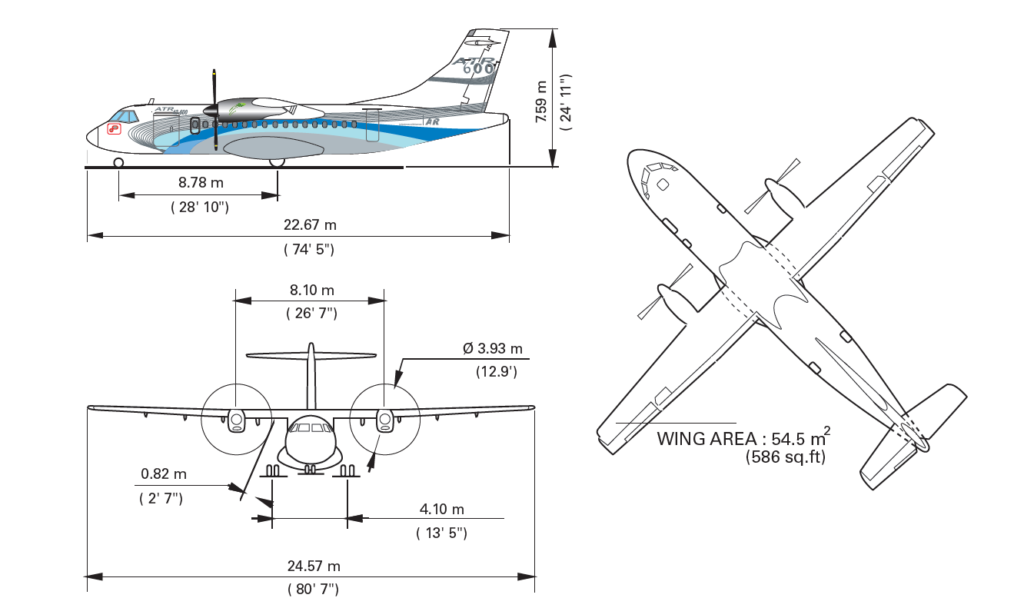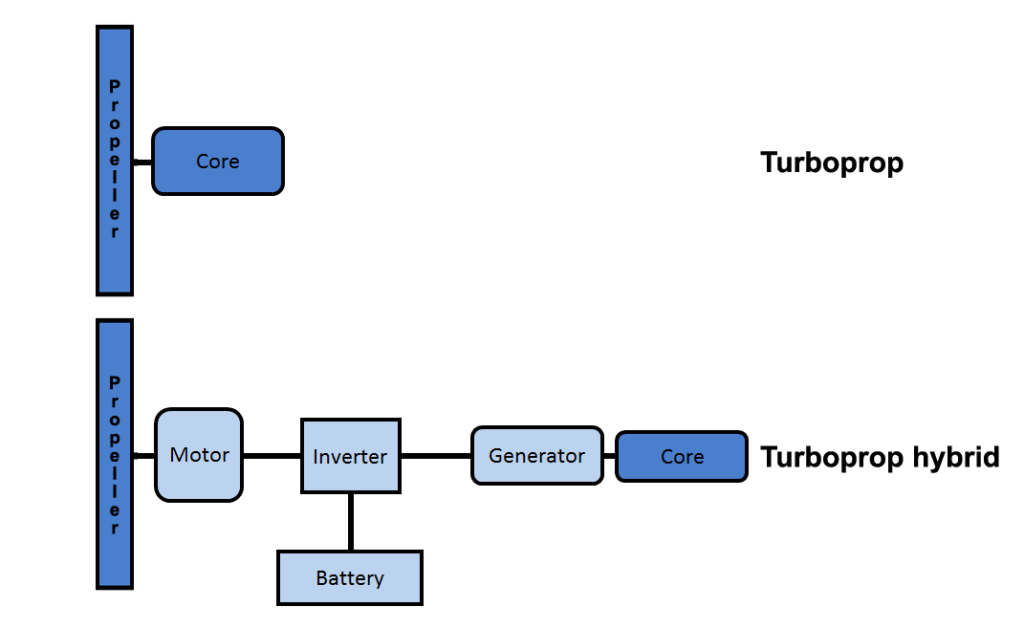Leeham News and Analysis
There's more to real news than a news release.
Bjorn’s Corner: Electric aircraft, Part 7
August 11, 2017, ©. Leeham Co: In this Corner, we will design the hybrid propulsion system for our 50-seat regional turboprop. We could see in previous Corners that we can’t use batteries as a backup for our gas turbine core and main generator.
The battery gets too heavy as the specific power weight of a battery is simply too low. We will now design a hybrid power chain with a different redundancy concept.
Turboprop power requirements
We will use the ATR42 data to deduce the power requirements for our regional turboprop. It might be that a new design could reach improved values by designing a higher aspect ratio wing for example.
But it’s wise to use an established design to do the first sizing. It has passed certification and can serve as our base case for our hybrid propulsion chain. Once through this example we can discuss how the different performance values could be improved with a more aggressive design approach.
Through the specifications for the ATR42-600 (Figure 2), we can deduce the power we need for take-off, single engine take-off and maximum continuous cruise.
The take-off and maximum continuous cruise is 2,160shp or 1,600kW. For One Engine Inoperative (OEI), it’s 2,400shp or 1,800kW. For normal cruise, the power will be 2,000shp or 1,500kW per engine, giving 4,000shp or 3.000kW total for our aircraft.
Redundancy concept
Before we start sizing the hybrid chain, we need to design a viable redundancy concept. To get propulsion redundancy, we need to go a different route than for the regional jet. A battery as a redundant power source gives to little energy per mass unit, as we saw in Part 5.
One-way would be to double all components in the hybrid chain (Figure 3). This is not to smart. We decrease the propulsion efficiency by 6% (see Part 3) and increase the installed weight.
Our plan with one larger core driving the chain for normal use is to increase the dimensions of the core and by it, its efficiency (Part 3). The aircraft then needs an additional, redundant, power source, to not have a single point of failure in the propulsion chain.
At the same time, we need a power source on the ground for cooling/heating the aircraft, for producing electricity and to start the core gas turbine with. The normal source for ground power is an APU (Auxiliary Power Unit).
APU as redundant power source
An APU is a small gas turbine, Figure 4. It’s designed to be small, light and reliable.
The sacrifice to get there is the fuel efficiency. Because of a low-pressure ratio (at or below 10) the thermal efficiency for APUs is not great. But this is not a problem; they run during ground stops and as a redundant power and air source during take-off or landing.
By choosing a large APU, the one for the Airbus A350 for example (HGT1700, figure 4), we get an APU that can function as our backup power source for our core turbine.
The HGT1700 delivers 1,300kW shaft power at a mass of 335kg. We then get 1274kW electrical power through our superconducting generator (98% efficiency). To get to our OEI 1,800kW propeller power through the electrical motor, we need to inject 1,826kW (we have a 98% efficient motor).
The missing 552kW we draw from our battery during the five minute OEI take-off time. Once on the downwind, the 1274 kW electrical power from the APU is enough for cruise and landing.
The battery now weighs 155kg instead of 5.8 tonnes. We use the superior power specific weight of fossil fuel to form the backbone of our redundancy concept while still utilizing a battery for the peak power part of the cycle.
In the net Corner, we will size the whole chain for weight and discuss some finer points about the use of the battery.







Maybe turbocharge the APU for brief bursts of energy if needed for critical redundancy?
Cliffhanger series of articles as we wait for the next one …
APU already is a turbo charger with the recip engine in between left out 🙂
following your idea you need the emergency (over)power capability for the whole train APU and its generator.
I think we should turbo super charger compound it.
145 kg is roughly the weight of seven car batteries – Doesn’t the ATR-42 carry an equivalent battery mass already? To me, the number seems wholly negligible.
In terms of regeneration the batteries could be recharged during decent, putting the props at the right angles and the APU could push back / move the aircraft on the ground. Saving some more fuel / noise. https://www.youtube.com/watch?v=Xz_eU_l0vMs Because there have to be some real advantages for the operators.
I really like this series – the suspense is thrilling!
As I see it, strictly speaking, you are now talking about a One Engine airliner. Having the APU and battery available as backups is not as reassuring as having two turboprops with propellers.
In addition, there must be a weight and efficiency penalty for using the oversized A-350 APU in the ATR-42.
That doesnt seem to be what hes saying. There will still be two turbine cores driving propellers but one turbine based generator as a backup power source.
Check back to part 5 where the regional jet based hybrid was discussed
To dukeofurl and BernardP,
it’s one main gasturbine driving the generator which in turn drives two motors which drives the propellers. But the main gasturbine and generator has another gasturbine and generator as a backup. It’s just smaller, designed to take the aircraft home from situations when the main gasturbine or generator does not function.
A one gasturbine and generator aircraft with two motors with propellers is the most efficient config if one can achieve redundancy for all eventualities.
I had understood correctly. I will optimistically concede it could be viewed as a one-and-a-half engine airliner 🙂
It’s well known, that planes with 2 gas powered engines are more cost efficient than planes with three or four engines. Nearly all modern airliners use therefore two engines.
But ist the cost structure of an electrical engine the same. I would expect that for an hybrid plane, the optimum number of gasoline powered engines and generators should also be low. But what is about the number of the electrical powerd fans for propulsion?
An electrical motor doesn’t need much maintenance and smaller units are easier to assemble, an planes the additional power for redundancy would lower the more engines are installed – and therefore the drag. Many small engines would also allow to decrease the size of the vertical stabilizer, which also decrease drag.
Furthermore many small engines distributed over the whole wing span, could be used to increase the airspeed over the wing at low aircraft speed (take off). This would generate a lot of lift with a rather small wing.
In my opinion, electrical propulsion needs different aircraft concepts than gas powered planes.
Bjorn has presented research that says otherwise.
The ones used were not optimized 4 engines.
I would like to hear what you think about Elon Musk’s idea of a VTOL supersonic aircraft with no classic control surfaces where the motors are gimballed for control. He estimates needing 400 Watt hours per kg density and 80% of the aircraft composed of batteries.
Some information here, but can find it all over the web. https://medium.com/@andrewt3000/what-do-we-know-about-elon-musk-s-electric-plane-design-981e704f59a3
Feasible? or unlikely to ever work. Remember, we are not talking about a classic plane as these articles assume.
VTOL Supersonic …no need to read any further
VTOL Supersonic Electric that is.
Somebody says so, so it’s real, environmental, visionary. Headlines & subsidies stream in. Join or be left behind. Welcome to 21st century realism.
https://lilium.com/
https://www.google.com/search?q=lilium+aviation
Combine your idea with the replacement of the propeller with small electric jet engines (ducted fans) similar those that are used on the lilium jet and you can probably add further gains :
Either reduce the wing span, and hence the drag during cruise, or have very low approach speed and stol capabilities.